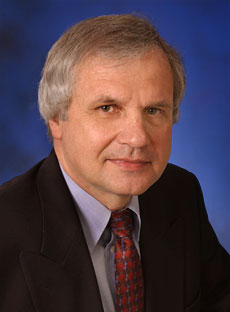Pavel Oblozinsky Marks A Decade of Preserving U.S. Nuclear Data
April 1, 2009

Pavel Oblozinsky
In this age of technology, a decade can bring transformational change in a field like computerized nuclear data storage. When Pavel Oblozinsky returns to his native Bratislava, Slovakia, next year, he will mark 10 years of modernizing the United States' libraries of publicly available nuclear data and bringing the National Nuclear Data Center (NNDC), headquartered at Brookhaven National Laboratory, into the 21st century. Oblozinsky recently stepped down as head of the NNDC, having served in that capacity since 2002 and as deputy head since his arrival at Brookhaven in 2000.
"We improved service dramatically," he said. "Since 2002, use of our services doubled every two years. We introduced the next generation of computer services and released the seventh generation of the reaction data library, providing support for nuclear physics and its many applications. If a new generation of nuclear reactors is developed, the data will be used for the next 100 years."
The NNDC collects, evaluates, archives and disseminates nuclear structure and nuclear reaction physics data for basic nuclear research and for applied nuclear technologies. It is arguably the oldest scientific organization at Brookhaven, in continuous operation here since 1951. It is funded primarily by the Department of Energy's Office of Science.
Oblozinsky called the increase in use of the NNDC libraries "unexpected." He observed that it is also used more often by the general public, and not just by scientists, and said there was "a noticeable up tick" in use of the site after the case of the Russian spy poisoned by polonium hit the newspapers a few years ago.
Oblozinsky began his career at the Slovak Academy of Sciences, where he received his Ph.D. in nuclear physics in 1973. During his years there, he served as head of the Nuclear Physics Department, where he developed both the coincidence technique to measure gamma production and tools for interpretation of the data. As a senior scientist there, he conducted extensive research in nuclear reaction mechanisms and gamma production and is best known for his numerous contributions to preequilibrium reaction models. Before joining the staff of the NNDC, Oblozinsky spent seven years as the deputy head of the Nuclear Data Section at the International Atomic Energy Agency (IAEA) in Vienna, Austria. During his years as head of the NNDC at Brookhaven, he also served as chairman of the U.S. Nuclear Data Program, and chair of the Cross Section Evaluation Working Group. This year, he received an Appreciation Award from DOE's Office of Science for "outstanding leadership to promote nuclear data efforts on an international level."
In addition to modernizing the computer operations of the Center, Oblozinsky addressed other issues affecting its future, including staff requirements.
"We are vigorously working with young scientists and post-docs," he said. "We are building the future."
Oblozinsky brought in one scientist in particular who will be critical to the future of the NNDC - its new head, Michal Herman, who worked under Oblozinsky at the IAEA and more recently at Brookhaven.
Oblozinsky's own future includes returning to part time work at the Slovak Academy of Sciences in Bratislava, just across the Danube River from Vienna, where his two sons live. Unlike during the Cold War days of his youth, he and his wife Ludmila will now find it easy to cross over the border to visit twin grandsons expected in May.
"It's like a miracle to us," he said.
2009-1168 | INT/EXT | Newsroom









